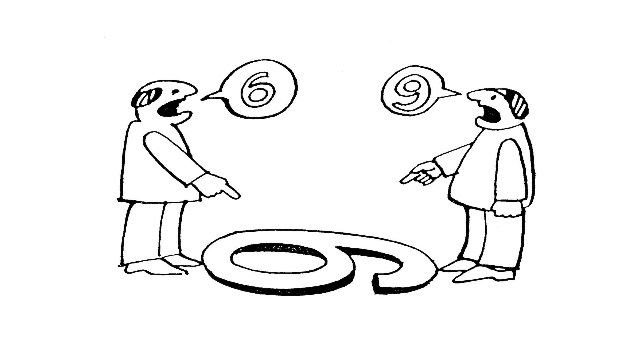I talk and think about empathy a lot. I’d like to break it down for myself. Let’s start with my favorite questions.
 First, what is it?
First, what is it?
The simple definition is “The ability to understand and share the feelings of another.” But that doesn’t really cut it for me. What does that literally mean? To “share the feelings of another” – how do we share feelings?
Here we need to move on to the next question, “How does it work?”
Now, there’s a lot of highly complex neurology that the scientific community is still figuring out, but I think I can boil it down to a simplicity that children can understand. Literally, empathy is using your imagination to pretend you are someone else in a different situation than you.
The least abstract use of this would be imagining what someone else can see. The two people pictured below are in need of empathy. They disagree because their perspectives are different, and neither is choosing to imagine what the figure might look like from a different angle. 
More commonly we think of empathy in the context of emotions. Sometimes it’s easy to empathize, like when a friend is in a situation we’ve been in before. The imagination easily conjures the appropriate emotions. But more often, it’s not so easy. The other person’s situation could be totally unfamiliar to us. Or we could be having some emotion that makes it hard to think rationally. When empathizing is difficult, we tend not to do it.
But why should we do it? Let’s get to that third question, “What is it for?”
The simple answer is that empathy is necessary for peace. When empathy is used to resolve conflicts, there is always more potential for compromise and contentment with the result. Empathy allows us to enjoy the positive feelings of another, which helps communities bond together. Empathy motivates us to help those in need. Empathy gives us the capacity to learn from the mistakes of others, which saves us a lot of trouble, I’m sure you’ll agree.
Obviously empathy is extremely useful. So let’s address question four, “What is my connection?” Or in this case, “How and when do I use it?”
My first instinct is to say ALL THE TIME, but there are times for disregarding the feelings of others, though they be rare. How do we know when one of those rare times is upon us? i.e. when is it okay to NOT be empathetic?
Well, try to be fair. Give yourself as much love and kindness as you would give any close friend or family member. Try to figure out if your feelings are wants or needs. This distinction is extremely important to be able to evaluate. It’s difficult though, so it requires a lot of practice.
To answer the question of how to use empathy, that also requires practice (ugh, just like everything else worth being good at). It requires an agile imagination. It requires good intentions. Empathy happens naturally all the time among humans, but it can also be experienced deliberately. I believe those times are when it is most powerful. Next time you feel angry, really try to imagine yourself in the other person’s position. Don’t ignore your own feelings, but give the feelings of others equal voice when making decisions.
Empathy is the solution to so many problems in human interactions and all you really need to use it is a little imagination. So go forth and practice empathy, and see how much more you enjoy your life.
p.s. Another way to enjoy your life is to look at pictures like this:
